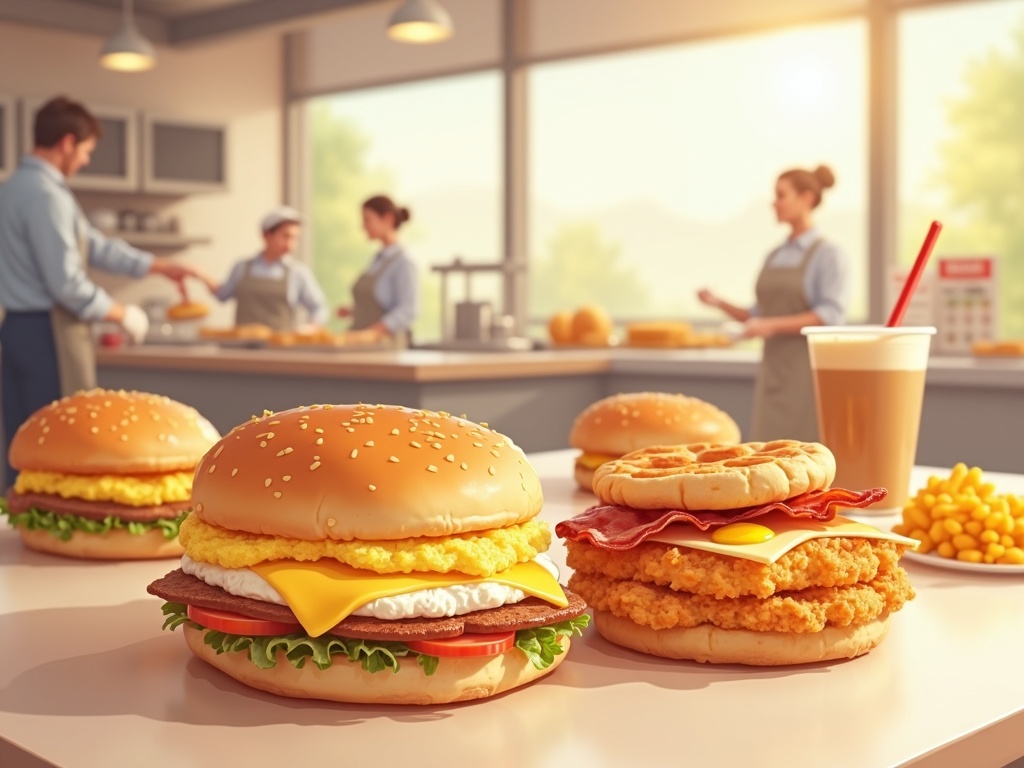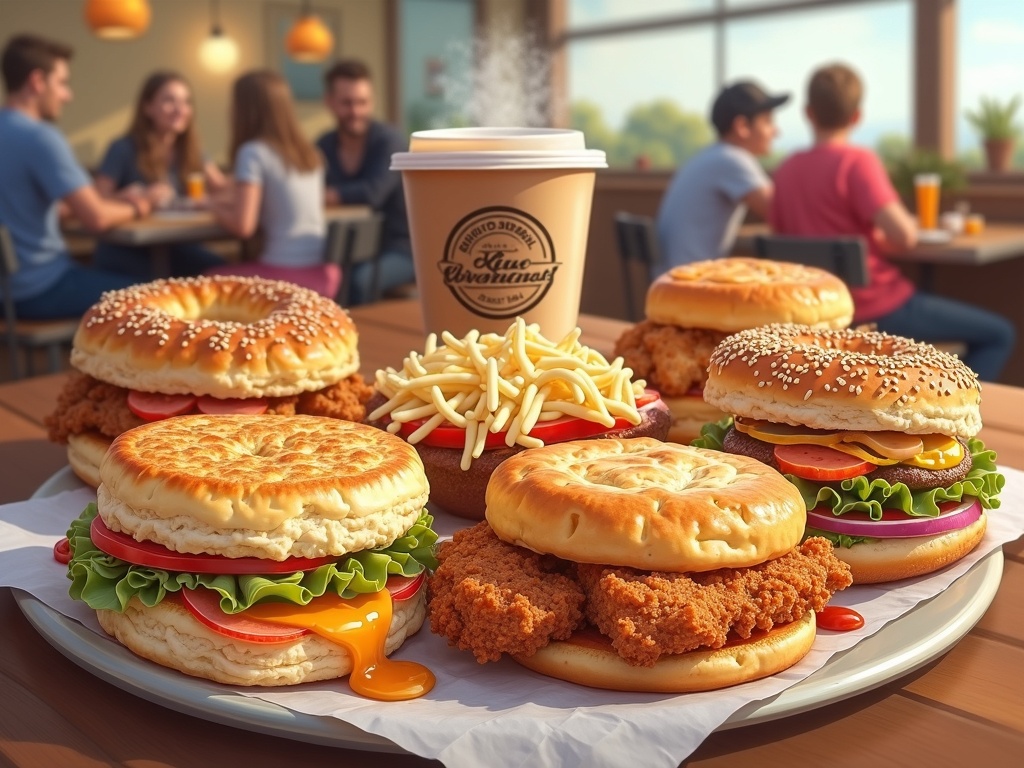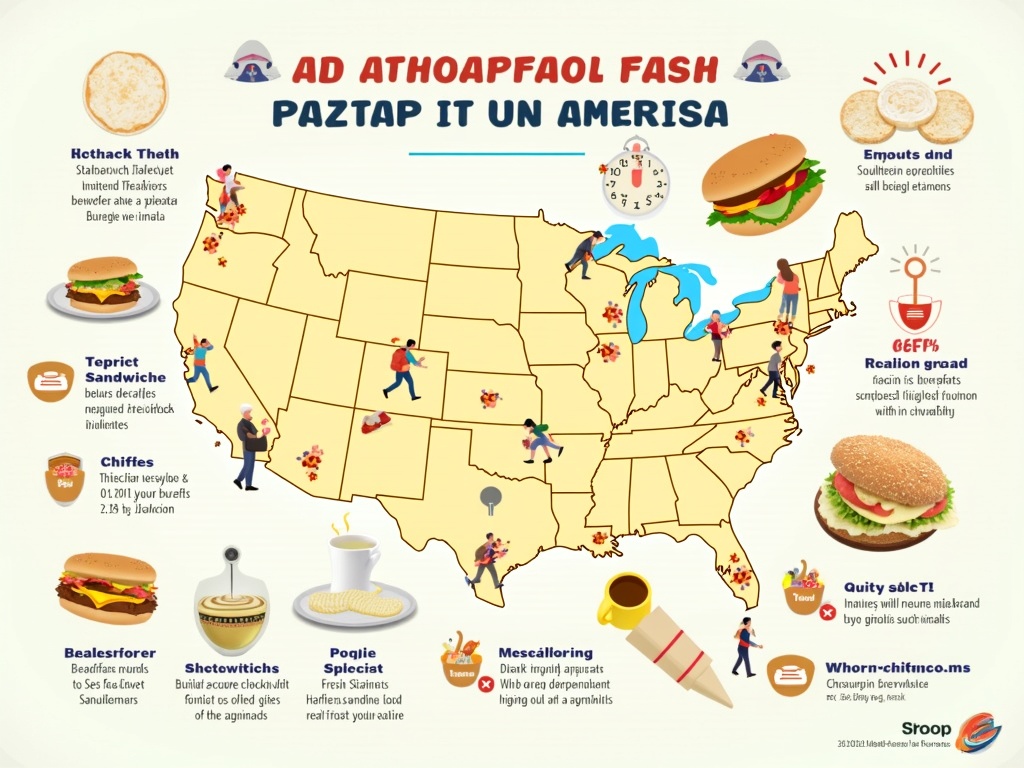Fast food breakfast has evolved into a $200 billion market growing at 5% annually, with 55% of consumers choosing quick-service morning options for their convenience and affordability. The industry has shifted from simple offerings to diverse menus featuring regional specialties, customizable options, and healthier alternatives that address changing consumer preferences and increasingly busy lifestyles.
Find In This Article
Key Takeaways
- Millennials lead the on-the-go breakfast trend with 39% regularly purchasing breakfast during their commute, compared to only 27% of Baby Boomers.
- Most fast food breakfast sandwiches contain between 300-600 calories, but can pack significant sodium (700-900mg) and saturated fat (5-12g).
- Regional preferences strongly influence menu offerings, with Southern-style biscuits, California breakfast burritos, and Northeastern bagel combinations appearing in their respective regions.
- Healthier breakfast options have emerged across chains, including whole grain breads, turkey bacon, egg whites, and vegetable additions.
- Digital ordering, delivery services, and app-exclusive promotions have changed how consumers access fast food breakfast while potentially saving money.
The Rise of Fast Food Breakfast in America
The breakfast landscape in America has transformed dramatically over the last decade. With the U.S. breakfast market now valued at $200 billion and growing at 5% annually, it’s clear that morning meals have become big business. I’ve noticed that fast food chains have capitalized on this trend, creating dedicated morning menus that cater to our increasingly busy lifestyles.
Convenience Drives Consumer Choices
Convenience dominates breakfast decisions for modern Americans. A striking 55% of consumers now choose fast food for their morning meal primarily because it fits into their hectic schedules. I find this shift particularly interesting when looking at generational differences:
- Millennials lead the on-the-go breakfast trend, with 39% regularly purchasing breakfast while commuting
- Baby Boomers show more traditional patterns, with only 27% opting for on-the-go options
- The average consumer spends between $5-7 for a typical breakfast sandwich and beverage combo
This price point hits the sweet spot for value-conscious customers who need quick energy to start their day. The affordability factor explains why McDonald’s breakfast menu has maintained such popularity despite increasing competition.
The breakfast wars aren’t limited to traditional burger chains. While McDonald’s maintains dominant market share, both Starbucks and Dunkin’ have carved out significant portions of the morning meal market. These coffee-forward chains have expanded beyond beverages to offer substantial food options that satisfy hunger alongside caffeine cravings.
For those exploring other options, Subway’s breakfast offerings provide a different approach with customizable morning sandwiches. Meanwhile, competitors like Wendy’s breakfast menu entered the scene more recently but quickly gained traction with unique items.
Timing matters too. Most chains have specific McDonald’s breakfast hours when morning items are available, though many now offer extended or all-day breakfast options to capture customers throughout the day.
The competition has intensified as Burger King breakfast and Taco Bell breakfast offerings add variety to the market with their distinctive flavor profiles and international inspirations.
Fast food breakfast has evolved from a convenience option to an essential part of American food culture, reflecting broader changes in our work patterns and daily routines.
What’s Really in Your Breakfast Sandwich
Fast food breakfast sandwiches have become my go-to option when I’m rushing to work or need a quick morning meal. But have you stopped to consider what’s actually in that handy package?
The Building Blocks of Breakfast
The typical fast food breakfast sandwich contains a predictable set of ingredients. Most feature some form of egg (either real or an egg mixture), protein like turkey bacon or beef sausage, cheese, and bread components that range from English muffins to biscuits, croissants, or tortillas for breakfast burritos.
These ingredients combine to create iconic offerings like the McDonald’s breakfast classic Egg McMuffin or the various breakfast burritos available at chains like Taco Bell breakfast locations. While the core elements remain consistent, each chain puts their unique spin on these morning staples.
The cooking process is relatively standardized across chains. Eggs are typically cooked at temperatures between 325-350°F for about 2-3 minutes, while meat products like sausage patties need to reach an internal temperature of 165°F. This consistency ensures the quick preparation these restaurants depend on.
Nutritional Reality Check
I’ve found that most breakfast sandwiches contain between 300-600 calories, which might seem reasonable until you consider the additional sides. Add hash browns and a sweetened coffee drink to your Burger King breakfast, and your morning meal can quickly exceed 1,000 calories.
The nutritional concerns don’t stop at calories. Most breakfast sandwiches pack significant sodium and fat content. For example:
- A standard breakfast sandwich can contain 700-900mg of sodium (nearly half your daily recommended intake)
- Saturated fat content typically ranges from 5-12 grams per sandwich
- Sugar content varies widely, with pancake platters at Wendy’s breakfast containing up to 40g of sugar
Making better choices is possible with a bit of knowledge. Egg-based items from Subway breakfast offerings tend to be lower in calories than biscuit-based options. Similarly, McDonald’s breakfast hours provide time to consider healthier alternatives like oatmeal or fruit cups to balance your meal.
I’ve learned that being informed about what’s in my breakfast sandwich doesn’t mean I can’t enjoy it – it just helps me make choices that align with my nutritional goals and understand exactly what I’m starting my day with.

Making Healthier Choices at the Drive-Thru
Navigating the fast food breakfast scene with health in mind doesn’t mean sacrificing flavor. I’ve discovered several strategic swaps that can transform your morning meal into something both satisfying and nutritious.
Smart Substitutions and Additions
Whole grain bread options have become increasingly available at major chains. Instead of the standard English muffin or biscuit, I opt for whole grain alternatives when available at places like McDonald’s breakfast menu. These provide more fiber and nutrients to start my day right.
Protein choices matter significantly in breakfast sandwiches. Turkey bacon offers a leaner alternative to traditional pork bacon, with less fat and fewer calories. Many establishments like Subway breakfast now feature turkey bacon options. Plant-based sausage alternatives have also emerged at chains like Burger King breakfast, giving vegetarians and health-conscious eaters more choices.
Egg whites have become a popular option across the fast food landscape. By choosing egg whites instead of whole eggs at places like McDonald’s breakfast hours, I cut down on cholesterol and fat while still getting quality protein.
Avocado spread presents another smart swap. Rather than loading up on butter or extra cheese, I ask for avocado when available. It provides healthy fats and creates a creamy texture without the downsides of processed spreads. Wendy’s breakfast menu sometimes features avocado options worth exploring.
Adding vegetables to breakfast sandwiches or bowls boosts nutritional value significantly. I request extra tomatoes, spinach, or peppers whenever possible. Taco Bell breakfast items can often be customized with extra veggies for nutrition without extra calories.
Many chains now highlight lighter menu sections specifically designed for health-conscious customers. These items typically feature calorie counts prominently displayed, making it easier to make informed choices during morning rushes.
By implementing these simple strategies, I’ve found that drive-thru breakfast can fit into a balanced diet without feeling like a compromise. The key lies in making thoughtful substitutions rather than avoiding fast food breakfast altogether.

Regional Fast Food Breakfast Favorites
The breakfast landscape across America tells a delicious story of regional preferences and cultural influences. I’ve discovered that fast food chains often adapt their morning menus to local tastes, creating distinctive breakfast experiences depending on where you’re dining.
Southern Comfort on the Breakfast Menu
Southern-style biscuit sandwiches reign supreme below the Mason-Dixon line. These flaky, buttery creations have become iconic breakfast staples with good reason. The perfect Southern biscuit provides a delicate balance – crisp exterior giving way to a soft, layered interior that practically melts in your mouth.
Fast food chains have embraced this regional favorite with their own spins:
- Buttermilk biscuits paired with fried chicken (a Southern tradition)
- Sausage gravy-smothered variations that offer comfort in every bite
- Ham and egg combinations that blend savory proteins with the biscuit’s buttery notes
Many McDonald’s breakfast locations in Southern states emphasize their biscuit offerings, knowing local customers expect this regional staple. The popularity has spread so widely that you’ll find these Southern-inspired items on menus nationwide, though locals will tell you nothing compares to the authentic versions found in Georgia or the Carolinas.
Meanwhile, on the West Coast, breakfast takes an entirely different direction. California breakfast burritos showcase the state’s fresh produce and Mexican influences. These hefty morning meals typically feature:
- Farm-fresh eggs mixed with local vegetables
- Avocado or guacamole adding creamy richness
- Regional hot sauces providing distinctive heat profiles
Taco Bell breakfast items particularly embrace these Southwestern flavors, offering portable morning options that reflect the state’s agricultural bounty and cultural diversity.
Regional Ingredients and Cultural Touchpoints
The Northeast brings its own breakfast identity to the fast food scene. Bagel combinations dominate in places like New York and New Jersey, where the chewy, dense bread serves as the foundation for countless morning creations. Subway breakfast options in these regions often feature bagel-based sandwiches that wouldn’t appear on menus in other parts of the country.
I’ve noticed that Wendy’s breakfast offerings sometimes incorporate regional ingredients that highlight local food cultures. For instance:
- Maple-infused items in New England
- Green chile additions in New Mexico
- Seafood components along coastal areas
These thoughtful adaptations show how national chains stay relevant by honoring local food traditions. Burger King breakfast menus in Texas might feature more robust spice profiles than their counterparts in Minnesota, reflecting regional flavor preferences.
Cultural influences further shape these regional distinctions. In areas with significant Hispanic populations, breakfast menus often include items inspired by Mexican morning traditions. Similarly, in the Pacific Northwest, coffee culture has pushed chains to elevate their morning brew offerings beyond what you might find elsewhere.
The timing of these regional offerings also varies, with McDonald’s breakfast hours sometimes extending longer in areas where late-morning breakfast is culturally significant. This regional customization demonstrates how even national chains understand that breakfast isn’t a one-size-fits-all experience.
What makes these regional breakfast variations so fascinating is how they’ve evolved from local traditions into mainstream menu items. A breakfast sandwich that originated to satisfy workers in one region might now be available nationwide, though often with subtle adaptations that acknowledge its roots while appealing to broader tastes.
By recognizing and celebrating these regional breakfast traditions, fast food chains create meaningful connections with local customers while introducing travelers to authentic morning flavors they might not otherwise experience.

Fast Food Breakfast Hacks and Customization
Breakfast at fast food restaurants doesn’t have to be ordinary. I’ve discovered several ways to transform standard menu items into customized meals that better suit my taste preferences and budget needs.
Flavor Enhancement Techniques
Adding your own touch to fast food breakfast can make a world of difference. Hot sauce is my go-to addition for nearly any breakfast sandwich or burrito. Many places keep packets behind the counter, so you just need to ask. For a more substantial kick, request jalapeños to be added to your egg sandwich or breakfast burrito. This simple addition transforms a basic McDonald’s breakfast sandwich into something with genuine flavor depth.
Another game-changing hack is requesting fresh-cracked eggs where available. While not all chains offer this, places like Subway breakfast menus sometimes allow you to specify how you’d like your eggs prepared. The difference in taste between a freshly cracked egg and a pre-made egg patty is remarkable.
Don’t be afraid to combine menu items for a completely unique creation. For example, I sometimes order a basic egg sandwich and a hash brown separately, then place the hash brown inside the sandwich for added texture and flavor. At Taco Bell breakfast, you can request to add potatoes to any breakfast item for a more filling meal.
Maximizing Value and Freshness
Fast food breakfast doesn’t need to break the bank. Most chains offer app-exclusive deals that can save you significant money over time. Wendy’s breakfast items often come with special promotions through their app, while Burger King breakfast frequently offers BOGO deals on their morning menu.
Timing your visit can make a huge difference in the quality of your meal. Generally, arriving between 8:00-9:00 AM means you’ll hit the sweet spot where breakfast rush is slowing down but food is still being prepared fresh. Weekday mornings usually offer the freshest preparation since staff can dedicate more attention to each order compared to busy weekends.
For those concerned about making it in time, knowing the exact McDonald’s breakfast hours or when your preferred chain stops serving morning items can help you plan accordingly.
I’ve found that being friendly with staff and making simple, specific requests often results in fresher preparation. Asking for “no salt” on hash browns usually means they’ll make a fresh batch just for you – then you can add your own salt afterward.

The Evolution of Quick-Service Breakfast
Fast food breakfast has undergone a remarkable transformation since first gaining popularity in the 1970s. I’ve watched this evolution unfold, from simple coffee and donuts to the diverse morning menus we enjoy today. The industry has responded to changing consumer demands while maintaining the convenience that made these options attractive in the first place.
From Home-Cooked to Grab-and-Go
The shift from home-cooked morning meals to convenience options began as American lifestyles became increasingly busy. Morning commutes grew longer, and two-income households became the norm, leaving less time for traditional breakfast preparation. Fast food chains recognized this opportunity and developed morning menus to capture this growing market segment.
Today’s landscape looks vastly different from those early days. While classics like McDonald’s breakfast items remain popular, many chains have expanded their offerings significantly. Subway breakfast options provide a fresh alternative, while Wendy’s breakfast menu represents a more recent entry into the morning competition.
Health and Sustainability Transformations
Recent years have seen a dramatic shift toward healthier and more sustainable breakfast options. This transformation includes:
- Growing demand for organic ingredients with chains sourcing eggs and dairy from certified organic farms
- Rise of plant-based breakfast alternatives beyond traditional meat options
- Increasing focus on sustainable packaging with compostable containers replacing styrofoam
- Calorie counts and nutritional information displayed prominently on menus
- More fresh fruit and vegetable options incorporated into breakfast items
The latest frontier in this evolution involves digital ordering and delivery innovations. Mobile apps have made it possible to order breakfast items for pickup without waiting in line. Delivery services have partnered with chains like Burger King breakfast and Taco Bell breakfast to bring morning favorites directly to homes and offices.
Timing remains crucial in the breakfast game. Most chains have specific McDonald’s breakfast hours and similar timeframes when morning items are available. This limited window creates both urgency and tradition around these morning offerings.
Fast food breakfast continues to evolve with changing consumer preferences. The focus on quality ingredients, sustainability, and digital convenience represents the latest chapter in this ongoing transformation. The basic promise remains the same—quick, affordable morning fuel—but how it’s delivered and what it contains has changed dramatically over the decades.

Sources:
Market Research Institute – Breakfast Trends
Health Foundation – Fast Food Nutrition
National Restaurant Association – 2023 Industry Report

